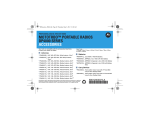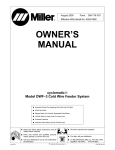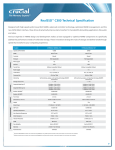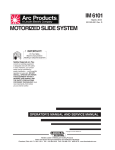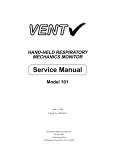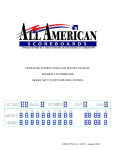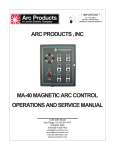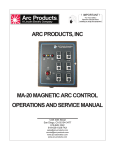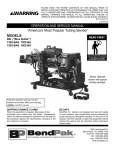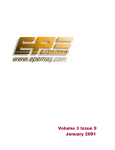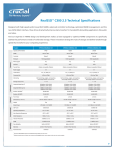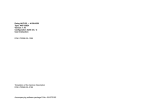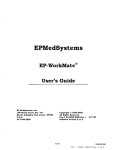Download DWF-4 Manual.pmd
Transcript
™ Automation ! IMP OR T ANT ! - F or Y our S afety R ead this manual before ins talling or us ing this equipment ARC PRODUCTS AUTOMATION DWF-4 TIG WIRE FEED SYSTEM OPERATIONS AND SERVICE MANUAL 1245 30th Street San Diego, CA 92154-34777 619-628-1022 619-628-1028 FAX [email protected] service@ arc-products.com www.ap-automation.com www.arc-products.com THANK YOU!!! . . . for purchasing Arc Products Equipment. Our commitment to you is to provide an ever expanding family of quality arc positioning equipment, controller and accessories. Please take a moment to read the following pages as they contain important information regarding proper use of this product and of welding/cutting safety and procedures. WHOM DO I CONTACT For help? • Contact your distributor For additional information, such as Technical Manuals, Service, and Parts, Circuit and Wire Diagrams, User’s Guides, Distributor Directories • Contact your distributor To file a claim for loss or How to contact Arc damage during shipment? Products: • Contact your delivering carrier. For assistance in filing or settling claims, • contact your distributor and/or equipment manufacturer’s Transportation Department Call: 619-628-1022 Fax: 619-628-1028 [email protected] [email protected] Arc Products Attn: Customer Service 1245 30th Street San Diego, CA 92154 0600-0312 Rev. A 4 0600-0312 Rev. A TABLE OF CONTENTS SAFETY DEFINITIONS SAFETY INFORMATION ELECTRIC SHOCK PERSONAL PROTECTION FIRE SAFETY VENTILATION SAFETY REFERENCES 7 7 7 8 8 9 9 INTRODUCTION 10 EFFECT OF CONTROLS AMPLITUDE CONTROL POSITION CONTROL SPEED CONTROL DWELL CONTROL CALIBRATION CONTROL 11 11 11 11 12 13 EXPLANATION OF FUNCTIONS – CIRCUIT DIAGRAM AP AUTOMATION PROBE CURRENT WAVEFORMS TYPICAL DWELL AND FREQUENCY WAVEFORMS PROBE-TO-TORCH MOUNTING ORIENTATION 14 15 16 17 TROUBLESHOOTING TOOLS REQUIRED INITIAL SET UP TROUBLESHOOTING CHART 18 18 18 19 GENERAL INFORMATION EFFECTS OF CONTROLS THEORY OF OPERATION TROUBLESHOOTING SPECIFICATIONS CONTROL UNIT PROBES PROBE TIPS 20 20 21 DRAWING & PARTS LIST Parts List & Diagram for Arc Osc. Cont. Assembly MA-20, 0600-0211 Control Block Diagram Parts List & Diagram for PCB Assembly, Control Circuit, 1022-0084 Parts List & Diagram for Power Supply Assembly Arc Osc., 1026-0086 Parts List & Diagram for PCB Assembly, Power Supply, 1022-0025 Parts List & Diagram for PCB Assembly, Power Amp, 1022-0122 Parts List & Diagram for Mother Board Assembly, Arc Osc., 1022-0009 Power Supply Assembly Schematic Circuit Diagram Parts List & Diagram for MP-1 Probe Assembly Parts List & Diagram for MP-2 Probe Assembly Parts List & Diagram for MP-100 Probe Assembly General Terms & Conditions 22 24 25 27 28 29 30 31 32 33 34 35 36 5 SAFETY 6 0600-0312 Rev. A 0600-0312 Rev. A SAFETY SAFETY !IMPORTANT! THIS MANUAL HAS BEEN DESIGNED FOR EXPERIENCED WELDING AND CUTTING EQUIPMENT OPERATORS AND MUST BE READ COMPLETELY BEFORE USING THIS EQUIPMENT. IF YOU LACK EXPERIENCE OR ARE UNFAMILIAR WITH THE PRACTICES AND SAFE OPERATION OF WELDING AND CUTTING EQUIPMENT, PLEASE CONSULT YOUR FOREMAN. DO NOT ATTEMPT TO INSTALL, OPERATE, OR PERFORM MAINTENANCE ON THIS EQUIPMENT UNLESS YOU ARE QUALIFIED AND HAVE READ AND UNDERSTOOD THIS MANUAL. IF IN DOUBT ABOUT INSTALLING OR OPERATING THIS EQUIPMENT, CONTACT YOUR DISTRIBUTOR OR THE CUSTOMER SERVICE DEPARTMENT OF Arc Products. DEFINITIONS Throughout this manual, NOTE, CAUTION, WARNING and DANGER are inserted to call attention to particular information. The methods used to identify these highlights and the purpose for which each is used, are as follows: SAFETY INFORMATION Safety is a combination of good judgement and proper training. Operation and maintenance of any arc welding and cutting equipment involves potential hazards. Individuals who are unfamiliar with cutting and welding equipment, use faulty judgement or lack proper training, may cause injury to themselves and others. Personnel should be alerted to the following potential hazards and the safeguards necessary to avoid possible injury. In addition, before operating this equipment, you should be aware of your employer’s safety regulations. BE SURE TO READ AND FOLLOW ALL AVAILABLE SAFETY REGULATIONS BEFORE USING THIS EQUIPMENT. ELECTRIC SHOCK NOTE Operational, procedural, and background information which aids the operator in the use of the machine, helps the service personnel in the performance of maintenance, and prevents damage to the equipment. CAUTION An operational procedure which, if not followed, may cause minor injury to the operator, service personnel and/or bystanders. WARNING An operational procedure which, if not followed, may cause severe injury to the operator, service personnel, or others in the operating area. DANGER THE VOLTAGES PRESENT IN THE WELDING AND CUTTING ENVIRONMENT CAN CAUSE SEVERE BURNS TO THE BODY OR FATAL SHOCK. THE SEVERITY OF ELECTRICAL SHOCK IS DETERMINED BY THE PATH AND THE AMOUNT OF CURRENT THROUGH THE BODY. A) Install and continue to maintain equipment according to USA Standard C1, National Electric Code. B) Never allow live metal parts to touch bare skin or any wet clothing. Use only dry gloves. C) When welding or cutting in a damp area, or when standing on metal, make sure you are well insulated by wearing dry gloves, rubber soled shoes, and by standing on a dry board or platform. D) Do not use worn or damaged welding or torch cables. Do not overload the cables. Use well maintained equipment. An operational procedure which, if not followed, will cause severe injury or even death to the operator, service personnel or bystanders. E) When not welding/cutting, turn equipment OFF. Accidental grounding can cause overheating and create a fire hazard. Do not coil or loop the cable around parts of the body. 7 SAFETY 0600-0312 Rev. A F) The ground cable should be connected to the workpiece as close to the work area as possible. Grounds connected to building framework or other locations remote to the work area reduce efficiency and increase the potential hazard of electric shock. Avoid the possibility of the cutting current passing through lifting chains, crane cables or other electrical paths. G) Keep everything dry you might touch, including clothing, the work area, welding gun, torch and welding or cutting machines. Fix water leaks immediately. Do not operate equipment standing in water. H) Never use a cutting torch or welding gun which is damaged or contains cracks in its housing. D) Always wear safety glasses or goggles when in a cutting or welding area. Use safety glasses with side shields or goggles when chipping slag or grinding. Chipped slag is hot and may travel a considerable distance. Bystanders should also wear safety glasses or goggles. E) Compressed gas cylinders are potentially dangerous, refer to the suppliers for proper handling procedures. F) Wear ear plugs or other ear protection devices when operating cutting or welding equipment. FIRE SAFETY I) Refer to AWS-Z49.1 for grounding recommendations. PERSONAL PROTECTION SKIN AND EYE BURNS RESULTING FROM BODY EXPOSURE TO ELECTRIC-ARC WELDING AND CUTTING RAYS OR HOT METAL CAN BE MORE SEVERE THAN SUNBURN. A) Use a proper face shield fitted with the correct filter (#10 or greater) and cover plates to protect your eyes, face, neck and ears from the sparks and rays of the cutting/welding arc when cutting/welding or observing cutting/welding. Warn bystanders not to watch the arc and not to expose themselves to the cutting/welding arc rays or to hot metal. B) Wear flameproof gauntlet-type gloves, a heavy longsleeve shirt, cuff-less trousers, high-topped shoes, and a welding helmet or cap (for hair protection) to protect the skin from arc rays and hot sparks or hot metal. C) Protect other nearby personnel from arc rays and hot sparks with a suitable nonflammable partition. 8 HOT SLAG OR SPARKS CAN CAUSE A SERIOUS FIRE WHEN IN CONTACT WITH COMBUSTIBLE SOLIDS, LIQUIDS OR GASES. A) Move all combustible materials well away from the cutting area or completely cover materials with a nonflammable covering. Combustible materials include but are not limited to wood, clothing, sawdust, gasoline, kerosene, paints, solvents, natural gases, acetylene, propane, and similar articles. B) Do not weld, cut or perform other hot work on used barrels, drums, tanks or other containers until they have been completely cleaned. There must be no substances in the container which might produce flammable or toxic vapors. C) For fire protection, have suitable extinguishing equipment handy for instant use. 0600-0312 Rev. A VENTILATION SAFETY NEMA Standard EW1-2.02 approved as ANSI C87.1-1976 outlines both usual and unusual service conditions for a welding power source. AP Automation products have been designed and manufactured to meet the usual service conditions as well as conform to the other NEMA standards. If an unusual service condition is required, Arc Products/AP Automation should be consulted. WELDING AND CUTTING FUMES AND GASES, PARTICULARLY IN CONFINED SPACES, CAN CAUSE DISCOMFORT AND PHYSICAL HARM IF INHALED OVER AN EXTENDED PERIOD OF TIME. A) INSTALLATION Install the equipment in accordance with OSHA and National Electrical Code Standards, or other applicable standards. A) At all times, provide adequate ventilation in the welding and cutting area by either natural or mechanical means. Do not weld or cut on galvanized, zinc, lead, beryllium or cadmium materials unless positive mechanical ventilation is provided to prevent inhaling fumes and gases from these materials. B) COOLING Locate the AP Automation Welding equipment so that airflow into the front and out of the back is not obstructed. Avoid placing the unit where dust or grinding particles will be directed into the unit. B) Do not weld or cut in locations close to chlorinated hydrocarbon vapors coming from de-greasing or spraying operations. The heat of arc rays can react with solvent vapors to form phosgene, a highly toxic gas, and other irritant gases. C) ACCESS Locate the AP Automation equipment where there is room for the operator to manipulate the controls or change the connections on either the front or the rear. Avoid placing the unit in a hallway or other area where foot traffic might be impeded. C) If you develop momentary eye, nose or throat irritation during welding or cutting, it is an indication that the ventilation is not adequate. Stop work and take the necessary steps to improve ventilation in the welding or cutting area. Do not continue to weld or cut if physical discomfort persists. D) SECURITY Locate the unit where it can be secured to a platform, deck or other structure that is capable of safely supporting the unit and any other potential load. D) Use an air supplied respirator if ventilation is not adequate to remove all fumes and gases. E) Beware of gas leaks. Welding or cutting gases containing argon are more dense than air and will replace air when used in confined spaces. Do not locate gas cylinders in confined spaces. When not in use, shut OFF the gas supply at its source. F) Refer to AWS Standard Z49.1 for specific ventilation recommendations. LOCATION OF EQUIPMENT (Service Operating Conditions) WARNING THE SMALL SIZE AND UNIQUE DESIGN OF AP AUTOMATION’S PRODUCT LINE REQUIRES THE OPERATOR BE AWARE OF CERTAIN SAFEGUARDS REGARDING THE PROPER PROCEDURE FOR PLACEMENT OF THE EQUIPMENT. GOOD JUDGMENT AND COMPLIANCE WITH YOUR PARTICULAR JOB SITE SAFETY REQUIREMENTS ARE ESSENTIAL. THE FOLLOWING SAFEGUARDS ARE RECOMMENDED. PORTABILITY WARNING THE SMALL SIZE AND UNIQUE DESIGN OF AP AUTOMATION’S PRODUCT LINE REQUIRE THAT THE OPERATOR BE AWARE OF CERTAIN SAFEGUARDS CONCERNING THE MOVEMENT OF THE EQUIPMENT. GOOD JUDGMENT AND COMPLIANCE WITH YOUR PARTICULAR JOB SITE SAFETY REQUIREMENTS ARE ESSENTIAL THE FOLLOWING SAFEGUARDS ARE RECOMMENDED: A) In lifting and carrying a power source it is recommended that two people be used. The unit is designed to be lifted using a suitably rated and inspected choker (made of rope or nylon) run through both handles. Refer to the applicable OSHA standards or contact AP Automation for any questions regarding the lifting of this unit. Accessory units of less than 25 Ibs. may be safely lifted by one individual. B) Never drag, pull or lift the unit by the cables. Always lift the unit using the handles provided. C) Never move the unit to a position that would allow its input and output cables to impede or block foot traffic. 9 SAFETY D) Move and lift the unit in accordance with OSHA job site standards. E) Do not allow the unit to remain operating when lifting or moving it. F) Never move a power source unless all 10 flange screws and nuts holding the top and bottom cases are tight. G) Do not lift a power source/wire feeder combination when the wire feeder is mounted to the power source handles. Always disassemble the wire feeder from the power source before lifting. DANGER ANY TIME AP AUTOMATION EQUIPMENT IS PLACED ABOVE GROUND LEVEL, THE POTENTIAL HAZARD OF THE UNIT FALLING EXISTS. SAFETY PRECAUTlONS AROUND ARC POSITIONING SYSTEMS AP Automation equipment employs the use of moving electromechanical components to position the weld head and torch. Operators should exercise caution when working with moving equipment. Care should be taken not to allow loose clothing, jewelry or hair to get caught in the equipment causing injury. All automated systems should be turned off and have AC power positively disconnected before maintenance or repair. 10 0600-0312 Rev. A SAFETY REFERENCES The following publications provide additional information on important welding safeguards. A) ANSI/ASC Z49.1-1988, American National Standard “Safety in Welding and Cutting”. B) Bulletin No. F4-1, “Recommended Safe Practices for the Preparation for Welding and Cutting Containers and Piping that have held Hazardous Substances”. C) OSHA Safety and Health Standards, 29CFR 1910, available from the United States Department of Labor, Washington, DC 20210. D) NFPA Standard 518, “Fire Prevention in Use of Cutting and Welding Processes”, available from the National Fire Protection Association, 470 Atlantic Avenue, Boston, MA 0021 0. E) NEMA Standards Publication/No. EW1-1989, Electric Arc-Welding Apparatus, approved as ANSI C87.1-1989. Available from National Electrical Manufacturers Association, 155 E. 44th Street, New York, NY 10017. 0600-0312 Rev. A EFFECTS OF CONTROLS GENERAL INFORMATION INTRODUCTION WIRE DRIVE UNIT AP AUTOMATION cold wire feed systems are designed for accurate application of filler wire into the weld or braze area. The DWF-4 is designed to be used for GTAW and PAW processes. The AP AUTOMATION Digital Wire Feeder System is made up of a positive feeding wire drive with a zero backlash 3-axis wire manipulator. This combination of components produces exceptionally good wire feeding characteristics. Systems will accommodate wire sizes from .020" dia. (.50mm) to .094" dia. (2.39mm) and feed at an adjustable rate, continuously variable from 0 to 300 inches per minute. A standard DWF-4 system is shown in Figure 1.1. The wire drive unit uses urethane rollers to grip the wire and feed it in either direction depending on the signals from the control unit. These rollers eliminate the need to change rollers when changing wire sizes from .020" (.50mm) dia. through .062" (1.57 mm) dia. wire. Special rollers are required for .094 (2.39mm) dia. wire. All wire can be loaded into the drive while it is operating. There is no need to handfeed the wire through the mechanism before operating. Inlet and exit guides are provided with the wire drive. one inlet guide covers the entire range of wire sizes from .020" dia. (.50mm) to .094" (2.39 mm) dia. Three exit guides cover the range of wire diameters. Two of the exit guides are for the .020" through .062" range. The third is for the .094" wire. The guides are stored inside the drive housing. If a drive for .020" -.062" wire is ordered then two exit and one inlet guide will be supplied. If a drive for .094" is ordered, then one exit and one inlet guide will be supplied. CONTROL UNIT The control unit uses solid state circuitry in its motor supply and control circuits and operates from a 115/230 V.A.C., 50/ 60 Hz line supply. Provisions have been made for forward or reverse jog to allow easy pre-positioning of the filler wire. Start of wire feed and control of speed may be accomplished manually, from the front panel, or remotely, through the interface connector located on the rear panel. The speed at which the wire will feed is pre-set through use of the “PUSH TO SET” function on the front panel and can be controlled within .10" per minute increments. A digital readout of wire speed is provided. Start delay and stop delay timers are also provided for cycle control. Timers can be pre-set within .10 sec. intervals from 0 to 9.9 seconds. WIRE GUIDE ASSEMBLY The wire guide assembly used with the DWF-4 wire drive unit consists of a guide mechanism, conduit, liners, and tip. The guide mechanism is constructed to allow full position adjustment for vertical, cross seam, feed angle and distance from the electrode. Tips and liners can be changed to suit the wire size being used (see information listed in Table 1.1) Standard length of the conduit supplied with the system is 36" (914.4mm). The length may be shortened by following steps 2.5.1 through 2.5.4 in the installation section. Table 1, Wire Guide Details WIRE SIZE ROLLER EXIT GUIDE LINER GUIDE TIP .020" DIA (0.50mm) .030" DIA (0.76mm) .035" DIA (0.89mm) .045" DIA (1.1mm) .062" DIA (1. 5mm) .094" DIA (2. 39mm) 1066-0084 1066-0084 1066-0084 1066-0084 1066-0084 1066-0092 1070-0051 1070-0051 1070-0051 1070-0051 1070-0086 1070-0116 2360-0951 2360-0951 2360-0951 2360-0951 2360-0960 NONE 1076-0038 2360-0137 2360-0137 2360-0145 2360-0153 2360-0099 You may also order a combination of the wire guide mechanism, tip, conduit assembly, and conduit liner together, as follows: WIRE SIZE .020" DIA (.50mml .030-.035" DIA (.76-.89mml .045" DIA (l.lmml .062" DIA (1.5mml .094" DIA (2.39mml .020-.062" DIA (.50-1.5mm) PART NUMBER 1060-0022 1060-0031 1060-0049 1060-0057 1060-0065 1060-0171* *This includes all tips necessary for operation from .020" DIA through .062" DIA in one package. 11 GENERAL INFORMATION 0600-0312 Rev. A INSTALLATION GENERAL SET-UP A standard AP Automation DWF-4 system is illustrated in Figure 2.1 with the necessary interconnections shown for a typical installation. The parts are listed below: Table 2, DWF-4 Components DWF-4 (.020-.062) DWF-4 (.094") Control Unit 0600-0217 0600-0217 Wire Drive Unit 1060-0006 1060-0014 Wire Guide Assembly 1060-0171 1060-0189 CONTROL UNIT LOCATION The control unit should be placed in a location that provides easy access to the controls and proper air ventilation for cooling. Adequate ventilation is provided by maintaining a minimum of 5" (127mm) of unrestricted space between the control unit sides and rear and the nearest obstruction. The location should be selected to minimize any dust, dirt, moisture or corrosive vapors the control unit could be subjected to. Control unit outline dimensions are given in Figure 2.2. 12 CAUTION THE CONTROL UNIT CAN OPERATE ON EITHER 100/120 VOLTS OR 208/230 VOLTS AC, 50 OR 60 HZ. BE SURE TO SELECT THE PROPER INPUT VOLTAGE ON THE REAR PANEL BEFORE CONNECTING TO POWER. 0600-0312 Rev. A EFFECTS OF CONTROLS 13 GENERAL INFORMATION 0600-0312 Rev. A WIRE DRIVE UNIT MOUNTING Figure 4 is an outline and a mounting dimension guide. The drive unit may be mounted using the inlet guide surface or the bottom surface (opposite the adjusting knob) through use of the existing tapped holes in the housing. The wire drive exit guide has a 7/16- 20 UNF external thread for mating with the supplied wire guide conduit for a DWF-4 system. ¼" -20 unc x .31" DP 2 Mounting Holes 4.0" 4.69" 4.31" Side 4.65" Wire Feed 2.45" 2.875" Ctrs 5.53" .62" 1.750" Ctrs 2 Bottom Mounting Holes .78" 1.65" 1.12" Wire Drive Unit 1-3/8" Dia. Barrel Torch ¼" -20 unc x .31" DP 2 Bottom Mounting Holes 3.75" Torch 8.25" Approx. Wire Guide Manipulator Figure 4, Wire Drive Unit and Wire Guide Manipulator Dimensions 14 0600-0312 Rev. A EFFECTS OF CONTROLS CAUTION IN APPLICATIONS WHERE HIGH FREQUENCY OR CAPACITIVE DISCHARGE START IS USED THE DRIVE HOUSING SHOULD BE GROUNDED TO THE SAME POTENTIAL AS THE WORKPIECE. THIS WILL PREVENT POSSIBLE DAMAGE TO THE WIRE FEED DRIVE.CAUSED BY ARCING. GROUNDING CAN BE ACCOMPLISHED THROUGH THE UNUSED THREADED MOUNTING HOLES IN THE DRIVE HOUSING. SOCKET SLEEVE NIPPLE FITTING COMPONENTS WIRE GUIDE MOUNTING a sharp cut-off wheel or a fine-tooth hack saw. Remove tape and trim any loose wires flush with tube stock. Any burrs on the bore of the tube stock should be removed with a knife. Clean the hose bore. The wire braid will tend to “neck down” on this end. This is characteristic of wire braid hose and can be used to advantage in the assembly of the fittings. Slip the socket over the “necked down “ end of the hose, positioned approximately 3” (76 mm) from the end. Mount nipple hex in a The guide mechanism portion of the wire guide assembly is made to accommodate a standard 1-3/8" (34.9mml diameter machine torch barrel (see Figure 2.4). Guide tips are available for specific wire sizes from .020" to .094" in diameter. The conduit, with proper liner, is attached to both the wire drive exit guide and the wire guide mechanism (see Table 1.1 for proper selection of these parts). Sharp bends in the conduit must be avoided. If shorter conduit lengths are required, see Section 2.51. CONDUIT LENGTH ADJUSTMENT The conduit as supplied is an assembled unit 36" (914 mm) in length. If shorter lengths are desired, the conduit may be cut and reassembled according to the following steps. A) Disassemble existing fitting on one end. Save the fitting components. Wrap hose with masking tape at cut-off point and cut square to length through taped area using vise. Work the hose bore over the nipple to size the tube and aid in separating the braid prior to fitting the sleeve. Remove hose from nipple. B) Push the sleeve over the end of the tube and under the wire braid by hand. Complete positioning of the sleeve by pushing the hose end against a flat surface. Visually inspect to see that tube stock butts against the inside shoulder of the sleeve. Set the sleeve barbs into the Teflon tube by pushing the assembly tool or a round nose tapered punch into the end of the sleeve and tube. 15 THEORY OF OPERATION 0600-0312 Rev. A Table 4, Wire Guide Assembly Parts list SIGNAL Remote Start/Stop Inhibit FWD/REV JOG Remote Speed Control Start Delay On Auto Feed Motor Pulse C) D) REMARKS 5-24 VDC, or contact closure signal to start 5-24 VDC, or contact closure signal to inhibit wire feed without stopping weld cycle Contact closure signal to drive wire forward or reverse 10K potentiometer or 0-1.235 volt signal for 0-300 ipm 24 VDC lamp, or relay drive during start delay 24 VDC lamp, or relay drive during automatic cycle wire feed 24 VDC low level signal pulse 1 pulse .0116 inches of wire travel. Lubricate nipple and socket threads. For stainless steel fittings, use a molydisulfide base lubricant (e.g. .Molykote Type G) ; lubricants containing chloride are not recommended. Other material combinations use standard petroleum lubricants. Hold the nipple with hex in vise. Push hose over nipple with twisting motion until seated against nipple chamfer. Push socket forward, and hand start threading of socket to nipple. Wrench-tighten nipple hex until clearance with socket hex is 1/32" or less. Tighten further to align corners of nipple and socket hexes. Clean and inspect all assemblies. After the conduit is prepared, the liner may be cut to length and installed as shown in Figure 2.4 and explained in Section 2.4. REMOTE CONTROLS A number of remote capabilities are available with the DWF4 system. On the rear panel of the control unit a connector is provided for remote operation. Optional remote controls are available such as the Remote Control Pendant, and Wire Feed Pulse Cycle Control. They have their own separate housings with cable and connector for mating directly to the control unit remote connector. See Section 6 for details. The remote connector, in addition to providing for the remote control connections, provides the user access to other wire feeder signals. This may be used to incorporate the DWF-4 into a complete welding package system. The signals available are listed in Figure 3.3 and are described in more detail in Section 3.4. AP Automation also provides an optional pre-wired connector and shielded cable for connection to these signals. (See Sections 3.4 and 6.1). CHANGING RETRACT DISTANCE The wire retract distance which occurs at the end of a wire feed cycle comes preset from the factory at .512 inches. This distance can be changed through the range of .085 inches to 1.28 inches by changing the “E” jumpers. (See Table 4.4) . 16 0600-0312 Rev. A THEORY OF OPERATION OPERATION PRECAUTIONS Verify the following before connecting power to control unit. A) Make certain the drive unit is grounded. B) Check that all connections are secure and properly installed. All connections should be made to the torch and power supply before applying power to the control unit. C) Should the cover of the control unit be removed for any reason, be sure the AC line cord is disconnected. D) Check line voltage selector switch on rear panel for proper input voltage being used. CAUTION THE CONTROL UNIT CAN OPERATE ON EITHER 100/120 VOLTS OR 208/230 VOLTS AC, 50 OR 60 HZ. BE SURE TO SELECT THE PROPER INPUT VOLTAGE ON THE REAR PANEL BEFORE CONNECTING CONTROL DESCRIPTION -DWF-4 Refer to Figure 6 for location of the following front panel controls. ON-OFF: Switches primary line voltage to the control unit. When power is ON, the power indicator will be illuminated. MANUAL START - OFF - REMOTE START: In the center OFF position, a wire feed cannot be initiated; in the up MANUAL START position, a wire feed cycle is started. If this switch is placed down, in the REMOTE START position, a wire feed cycle can be initiated by applying an external signal to the proper pins of the remote connector on the rear panel. (See page ??? for complete details on REMOTE START.) The feed cycle stops for the DWF-4 system when either the REMOTE START (if used) or the MANUAL START switch is placed in the OFF position. REVERSE -FORWARD JOG: Pressing the Jog Switch down, to the FORWARD position, will cause wire to feed out of the wire drive unit at the rate of 102.4 inches per min; (2601 mm/min) this speed is factory set and cannot be changed. Pressing the Jog Switch up, to the REVERSE position, will cause wire to be pulled back into the wire drive unit -also at 102.4 inches per min. (2601 mm/min). Releasing the switch will cause it to return to the center OFF position. In this way wire can be pre-positioned for the weld cycle. START DELAY: Allows for a delay between the time a weld cycle is initiated and the time when wire feeding begins; START DELAY is preset table in .1 second increments, from 0.0 to 9.9 seconds. then stops feeding. STOP DELAY allows for crater fill and is variable from 0 to 9.9 seconds in .1 sec. intervals. WIRE SPEED: Digital display that indicates WIRE SPEED in inches per minute, in .1 inch per minute increments. PUSH TO SET: Used in conjunction with the SPEED control to preset wire feed rate. Pressing this switch while rotating the speed control allows the operator to preset the wire feed rate without actually feeding wire, thereby eliminating waste of filler wire. SPEED CONTROL: When in the STANDARD position, wire speed is controlled by the SPEED potentiometer located directly under the digital display on the control panel. When in the REMOTE position, wire speed is controlled by a REMOTE signal. SEQUENCE OF OPERATION After the DWF-4 has been installed, make sure all cables and connectors are properly mated. Check the line voltage selector switch on the rear panel to ensure it is set at the proper position to match the line voltage being used. The MANUAL/REMOTE switch should be in the OFF position. Back off thumbscrew on the drive unit to allow introduction of wire between drive rolls. Turn the power switch ON. The POWER indicator should illuminate and the digital display should read all zeros. Adjust thumbscrew to provide contact on wire. Activate the FORWARD Jog Switch and “guide” the filler wire into the wire drive entrance guide. The rollers will “pick up” the wire and begin feeding. Continue feeding the wire FORWARD until the wire is in position at the end of the guide tip. Use JOG FORWARD/REVERSE to adjust position. Select the desired amount of START DELAY by setting the thumb-wheel switches to the appropriate value. Do the same for STOP DELAY or FEED TIME as applicable. Next, select the WIRE SPEED by pressing the PUSH TO SET button. While holding this button in, rotate the SPEED knob until the desired WIRE SPEED is indicated on the digital display; set the SPEED CONTROL selector switch to the STANDARD position. Positioning the MANUAL START/ REMOTE START switch to the MANUAL START position will now initiate a wire feed cycle. The digital display will blink during START DELAY time. At the end of START DELAY, wire will begin to feed and the speed will be indicated on the display. Re-setting the MANUAL START switch to OFF will initiate the end of a wire feed cycle for the DWF-4. After STOP DELAY times out, the motor on the wire drive unit will reverse and retract the filler wire from the weld puddle; after the retract time, wire will stop feeding and the cycle is complete. STOP DELAY: Allows for a delay between the time when a weld cycle is terminated and the time when wire retracts 17 THEORY OF OPERATION 0600-0312 Rev. A Figure 6, DWF-4 Rear Panel 18 0600-0312 Rev. A THEORY OF OPERATION REMOTE SIGNALS Electrical connections are made as shown in Figures 7, 8, and 9. A pre-wired connector and cable is available from AP Automation (P/N 1074-0045). REMOTE START is implemented by applying a signal between PIN C and F. PIN C is the positive terminal and PIN F is the negative terminal. This signal should be 5-24 VDC. The cycle will remain active as long as the signal is applied. The cycle terminates when the signal is removed. MOTOR PULSE signal is an output that signals each step of the feed motor. This signal is a 24V, 18-sec wide pulse with a 10K source resistance. It may be used for a tachometer output of wire length output. Each pulse represents .0116 inches of wire feed. The signal is on PIN H; return is ground (PIN D). Figure 7, REMOTE WIRING CABLE Pins { The DWF-4 control unit has the capability of being controlled from a remote location. Seven signals are available as described in Table 4 as well as the following paragraphs. I J H The INHIBIT FUNCTION is implemented by applying a signal to PINS E and G; PIN E is positive and PIN G is negative. This signal should be 5-24 VDC. When the inhibit signal is applied, the wire feed is interrupted, but the cycle is not affected at its point in the cycle. When the inhibit signal is removed, the wire feed will continue. This feature is helpful for manual override or a pulse synchronization of wire to a pulsing power source. REMOTE JOG FORWARD/REVERSE is implemented by the use of a SPDT switch. The center pole is connected to PIN D. The forward pole is connected to PIN D. The forward pole is connected to PIN L, and the reverse pole is connected to PIN K. This switch is now wired in parallel with the Jog switch on the front panel, and functions in the same manner. REMOTE WIRE SPEED control is implemented in much the same way. A 10K 1/2W potentiometer is connected with its wiper (center pole) on PIN N. The plus reference voltage pole is connected to PIN M and the minus or ground pole is connected to PIN A. This pot is now selected by switching the speed control switch on the front panel (lower right corner of wire speed area) to the REMOTE position. Wire speed is now determined by setting this pot. The wire speed may also be controlled by a 0 to 1.235 volt signal (PIN A to PIN N which corresponds to O to 300 inch per minute wire speed). BROWN START DELAY BLACK NO CONNECTION RED AUTO FEED BLACK NO CONNECTION ORANGE MOTOR PULSES BLACK NO CONNECTION B YELLOW +20 VOLTS D BLACK DIGITAL GROUND A BLACK ANALOG GND N GREEN WIPER M BLUE POT (REF) BLACK NO CONNECTION E WHITE INHIBIT (+) G BLACK INHIBIT (-) C RED START (+) F WHITE START (-) L RED FORWARD K GREEN REVERSE The remote start function requires a signal of +5 to 24 VDC. This signal is applied to PIN C of J3. The common is from the DWF-4. This signal is optically isolated from the DWF4; therefore, the signal common need not be attached to the control unit ground. This signal would normally come through the normally open contacts of a relay that is activated at the start of a weld cycle, for example, the AP Automation Seam Tracker interface relay. The inhibit function requires a signal of +5 to 24 VDC applied to PIN E of J3, and common connected to PIN G of J3. The inhibit signals are optically isolated from the DWF-4 control unit, and the common need not be connected to the control unit ground. Figure 8, REMOTE START WIRING REMOTE START DELAY signal is an output that signals when the system is in the DELAY timing mode. When the START DELAY times out, the signal is removed. This signal is 24 VDC 500mA max current. It may be used to light a remote indicator lamp or energize a relay coil. The signal connects to PIN I of the remote connector; return is ground (PIN D). REMOTE AUTO FEED signal is an output that signals when the system is feeding wire automatically at the selected rate. Its output characteristics are the same as the remote start delay signal. The signal is on PIN J at the remote connector; return is ground (PIN D). PIN B PIN C PIN F PIN D +20 VDC REMOTE START (+) REMOTE START (-) GROUND Figure 9, INHIBIT FUNCTION WIRING PIN B PIN E PIN G PIN D +20 VDC INHIBIT (+) INHIBIT (-) GROUND 19 TROUBLESHOOTING 0600-0312 Rev. A MAINTENANCE AND REPAIR MAINTENANCE REQUIREMENTS CONTROL UNIT CALIBRATION The DWF-4 wire feed system has no special scheduled maintenance requirements. However, periodic inspection of control and wire drive is helpful in preventing equipment failures. Replace any worn or broken parts found. Periodic dust and oil removal from both the control and drive is recommended. The control unit has been calibrated and fully tested before leaving the factory. It is unlikely that it would require adjustment, however, if the need for re-calibration arises, there are three adjustments that can be made that affect wire speed and delay time accuracy. The only test equipment required is a good quality frequency counter of known accuracy. Refer to Figure 11 for easy location of the potentiometers and test points. Two adjustments, R2 and R7 affect wire speed accuracy. Perform the following steps to calibrate the control unit. GENERAL PRECAUTIONS Figure 10 shows a control unit for the DWF-4 system. Assemblies and parts that are authorized for user replacement are listed in Table 6. Should the user experience a problem and determine the defective part (see TROUBLESHOOTING, Table 5), the suggested repair procedure is to remove and replace the defective part. Figure 11 and Table 7 provide a detailed parts breakdown of the circuit board assembly. CAUTION WHEN INSPECTING OR REPAIRING A) Connect the frequency counter to TP 14. B) Rotate the speed control knob on the front panel to its minimum speed setting, i.e. fully counter-clockwise. Now adjust R7 until the frequency counter indicates zero. C) Repeat Step B). There is only one adjustment to be made on the time base osc. -R10; it sets the start and stop delay accuracy and the wire speed readout accuracy. D) Connect the frequency counter to TP 2, and adjust R10 for a reading of 2560 Hz ± 1 Hz. THE CONTROL UNIT ASSEMBLY, DISCONNECT AC POWER FROM THE UNIT BEFORE REMOVING THE COVER TO PREVENT ELECTRICAL SHOCK. NOTE REPEAT STEPS B) THROUGH D) IF THE ADJUSTMENT ON R10 IS CHANGED. 20 0600-0312 Rev. A TROUBLESHOOTING TROUBLESHOOTING CHART Table 5, Troubleshooting Guide TROUBLE INDICATION 1 Power ON lamp does not REPAIR STEPS a Verify that power cord is plugged in and circuit breaker is reset. light. b Verify that all plugs are installed in the circuit board. c Check +20v (TP 9, Figure 11). Replace board if necessary. d Check lamp; replace if necessary. 2 Digital display does not a Repeat Steps a, b and c above. light. b Check +5v (TP 12, Figure 11). Replace board if necessary. c Replace digital display board 3 Incorrect START/STOP a Repeat Step 1-b above. delays b Recalibrate (see Section "Control Unit Calibration"). c Replace thumbwheel assembly or circuit board. 4 Feed cycle does not start a Verify that MANUAL START/OFF/REMOTE switch is in correct position. b Repeat Step 1-b above c Replace circuit board. 5 Incorrect wire feed speed a Verify that SPEED CONTROL switch is in correct position. b Repeat Step 1-b and 3-b above. c Check input signal (TP 15, Figure 11). Replace speed pot or circuit board if necessary. d Verify that thumbscrew is fully seated. Exception: Back off one full turn when using .020" dia. wire. e Verify that correct drive rolls for wire diameter are installed (see Table 1). f Check roller surface; if excessively worn, slip off urethane wheels and replace. 6 Motor turns but wire does a Verify that drive unit is connected to control. not feed. b Repeat Step 1-b above. c Check motor and cable continuity. It should be about 1.5 ohms from PIN A, D, E and C referenced to pin B on motor connector. Repair or replace if necessary. d Check motor current (speed less than 10 ipm = 80-110 mv between TP 7 and TP 8 - see Figure 11). Replace circuit board if necessary. e Loosen feed tension adjustment knob completely. Verify wire runs smoothly off wire reel and through guides and conduit. f Verify thumbscrew is properly adjusted. Exception: Back off one full turn when using .020" dia. wire. g Verify correct drive rolls for wire diameter. (See Table 1) . h Check roller surface; if excessively worn, slip off urethane wheels and replace. 21 DRAWING & PARTS LISTS 0600-0312 Rev. A DRAWING & PARTS LIST Figure 10, Control Unit Assembly, PN 0600-0217 22 0600-0312 Rev. A DRAWING & PARTS LISTS Table 6, Parts List for Control Unit Assembly ITEM QTY PART No. DESCRIPTION 1 1 1066-0009 CHASSIS ASSY 2 1 1062-0007 PWB DWF-4 CONTROLLER/DRIVER 3 1 1062-0015 PWB DWF-4 DISPLAY AND DRIVER 4 1 1066-0041 TRANSFORMER ASSY, DWF-4 5 1 1066-0033 ASSY, THUMBWHEEL SWITCH 6 1 1066-0025 ASSY, THUMBWHEEL SWITCH 7 1 1074-0011 CABLE ASSY,DWF-4 INTERNAL INTERFACE 8 1 1074-0029 CABLE ASSY,DWF-4 DRIVE INTERFACE 9 1 2066-0139 SWITCH, JOG FWD/REV OR 120/140 VOLT 10 1 2120-0131 CIRCUIT BREAKER ETA TYPE, 1 AMP 11 1 2060-0047 SWITCH, JOG FWD/REV 12 1 2060-0071 SWITCH, SPEED CONTROL,STAND/REMOTE 13 1 2624-0051 POT 10K,10 TURN,SPEED CONTROL 14 1 2062-0056 SWITCH, MOMENTARY, PRESS TO SET 15 1 2060-0055 SWITCH, REMOTE START/MANUAL START 16 1 2060-0063 SWITCH, POWER ON/OFF 17 1 941000-011 LAMP POWER ON INDICATOR 18 1 2120-0123 RFI FILTER AC INPUT LINE 23 DRAWING & PARTS LISTS 0600-0312 Rev. A DWF-4 CONDUIT A/R A/R Figure 5, Wire Guide Assembly 24 0600-0312 Rev. A DRAWING & PARTS LISTS Table 3, Wire Guide Assembly Parts list ITEM QTY PART No. DESCRIPTION 1 1 1070-1066 BODY MANIPULATOR MACHINED 2 1 1070-1074 PIVOT -WIRE MANIPULATOR 3 1 1070-1023 KNOB, VERT. ADJ -WIRE MANIP. 4 1 1070-1031 CLAMP, WIRE MANIPULATOR 5 1 1076-1035 RACK -WIRE MANIPUALATOR 6 1 1070-0167 CLAMP , TORCH 7 1 1070-1091 COUPLING, MANIPULATOR, TWECO 8 1 2408-1079 SCREW, THUMB 10-32 ST STEEL 9 1 2408-1296 SCREW, THUMB 10 2 1076-0097 FITTING MODIFIED 11 1 2380-0187 HOSE, FLEX -TEFLON LINED 12 1 2360-1567 TIP, WIRE GUIDE, .020 13 1 2360-1575 TIP, WIRE GUIDE, .035 14 1 2360-1583 TIP, WIRE GUIDE, .045 15 1 2360-1591 TIP, WIRE GUIDE, .062 16 1 2360-1605 TIP, WIRE GUIDE, .030 17 1 2360-1613 TIP, WIRE GUIDE, .052 18 1 2360-0099 TIP, WIRE GUIDE, .094 19 A/R 2360-0951 LINER, CONDUIT 20 A/R 2360-0960 LINER, CONDUIT 25 DRAWING & PARTS LISTS 0600-0312 Rev. A Figure 10, Controller/Driver PWB Assembly, PN 1062-0007 Table 6, Parts List for Controller/Driver PWB Assembly 26 QTY PART No. 1 1 1 2 1 1 1 1 1 4 1 1 1 1 2 3 3 1 1075-0041 1175-0044 2208-0571 2208-0563 1108-0555 2208-0385 2208-0377 2208-0580 2820-0072 2800-0251 2810-0311 2800-0375 2800-0626 2800-0227 2800-0065 2800-0359 2800-0022 2800-0014 DESCRIPTION REF. DESIGNATION PWB,DRILLED -CONT/DRVR HEATSINK,SWITCH -PWR DRIVE CONN,RECT,PLUG (14CKT) CONN,RECT,PLUG (9CKT) CONN,RCT,PLUG (6CKT) CONN,RECT,PLUG (8CKT) CONN,RECT,PLUG (6CKT) CONN,RECT,PLUG (16CKT) IC V TO FREQ CONVERTER IC,HEF4510BP IC,TIMER IC,MCI4518BCP IC,MCI4020BCP IC,CD4085B3 IC,CD4013B3 IC,MC14093BCP IC,CD4001B3 IC,CD4001A3 Item 1 Item 2 J3 J4,J7 J6 J1 J2 J5 U1 U8-U11 U20 U3 U6 U23 U7,U22 U16-18 U2,U13,U21 U5 0600-0312 Rev. A DRAWING & PARTS LISTS Table 6, Continued, Parts List for Controller/Driver PWB Assembly QTY PART No. DESCRIPTION REF. DESIGNATION 1 3 1 1 1 2 1 3 3 2 4 5 1 4 6 4 8 1 4 2 2 32 2800-0324 2800-0421 2820-0161 2718-0060 2718-0043 1066-0017 1070-0019 2708-0162 2708-0138 2712-0091 2712-0105 2712-0121 2700-0037 2702-01.51 2700-0029 2702-0097 2702-0038 2502-0278 2502-0057 2504-0040 2506-0156 2500-0307 IC,MC14077BCP IC,MC14584BCP IC,OPTO ISOLATOR REG,+15V,U17812UC REG,+5V,UA78057C CORE ASSY INSULATOR,CORE XSTR XSTR,POWER,80V XSTR , NPN MPS A05 XSTR,NPN FREQ 100 XSTR,PNP FRQ 100 DIODE DIODE,RECT 5A 100V DIODE,SIGNAL DIODE,RECT DIODE,RECT 1.0A 100V CAP,ELCTLT 1000UF 75VDC CAP,ELCTLT 1000UF 35V CAP,TANT,10UF 25V CAP,3 MFD, 100V, 10% CAP,CER .1UF 100V 1 4 1 7 2 2 1 1 1 1 1 1 1 15 2 7 1 1 3 4 1 1 2 2 2 1 2 1 1 4 1 4 1 15 2800-0260 2500-0218 2500-0161 2500-0196 2614-0013 2622-0114 2622-0131 2622-0106 2606-3442 2606-4872 2606-4376 2606-3931 2606-4651 2600-3709 2600-2800 2600-3822 2600-2e51 2600-2907 2600-2311 2600-3211 2600-5507 2600-4071 2600-3725 2600-1374 2600-3873 2602-2622 2602-2801 2604-1694 2604-1716 2604-1546 2604-1473 3036-0001 2610-0917 2340-0324 IC,CD4516BE CAP,CER .01UF 50V CAP,CER .001UF 100V CAP,CER .001UF 200V RESISTOR NETWORK-SIP 47K POT,TRMR, 10K POT, TRMR, 20K POT,TRMR, 1K RES MF 3.83K 1/10W 1% RES MF 118K 1.10W 1% RES MF 35.7K 1/10W 1% RES MF 12.4K 1/10W 1% RES MF 69. 8K 1/10W 1% RES CARB 10K 1/4W 5% RES CARB 1.0K 1/4W 5% RES CARB 22K 1/4W 5% RES CARB 1.5K 1/4W 5% RES CARB 2.0K 1/4W 5% RES CARB 510 OHMS 1/4 5% RES CARB 5.1K 1/4W 5% RES CARB 1.00M 1/4W 5% RES CARB 47K 1/4W 5% RES CARB 12K 1/4W 5% RES CARB 47 OHMS 1/4W 5% RES CARB 27K 1/4W 5% RES CARB 820 OHMS 1/2W 5% RES CARB 1. 0AR 1/2W 5% RES CARB 3. 3AR 2W 5% RES CARB 3.9K 2W 5% RES CARB 680 OHMS 2W 5% RES CARB 330 OHMS 2W 5% WIRE NI CHROME RES WW 5 OHMS SW 3% LUG,TEST POINT U15 U4,U14,U24 U19 VR1 VR2 L1,L2 Item 3 Q1,Q3,Q4 Q2,Q5,Q6 Q13,Q14 Q7,Q8,Q9,Q12 Q1Q,Q11,Q19-21 CR28 CR7-CR10 CR18, CR20-22,25,CR27 CR1-CR4 CR5,CR6, CR11-CR14, CR23,CR24 C1 C2,C6, C.l2,C13 C4,C8 C10,C11 C3,C5,C7, C9,C14,C16, C22,C26, C30-C41, C43-C54 U12 C20,C27-C29 C17 C15,C18,C19, C21,C23-C25 RN1,RN2 R10,R22 R7 R2 R3 R9 R11 R21 R25 R4-R6,R8, R12-R16,R18,R47-49,R75,R83 R17,R87 R19,R28,R30, R34,R35,R40,R41 R23 R24 R27,R32,R33 R36,R38,R43,R44 R74 R82 R78,R79 R80,R81 R88,R89 R31 R46,R77 R26 R29 R37,R39,R42,R86 R45 R84,R85 R20 TP1-TP12,14,15 27 DRAWING & PARTS LISTS 28 0600-0312 Rev. A QTY PART No. DESCRIPTION 4 1 7 2500-0218 2500-0161 2500-0196 CAP,CER .01UF 50V CAP,CER .001UF 100V CAP,CER .001UF 200V 2 2 1 1 1 1 1 1 1 15 2614-0013 2622-0114 2622-0131 2622-0106 2606-3442 2606-4872 2606-4376 2606-3931 2606-4651 2600-3709 RESISTOR NETWORK-SIP 47K POT,TRMR, 10K POT, TRMR, 20K POT,TRMR, 1K RES MF 3.83K 1/10W 1% RES MF 118K 1.10W 1% RES MF 35.7K 1/10W 1% RES MF 12.4K 1/10W 1% RES MF 69. 8K 1/10W 1% RES CARB 10K 1/4W 5% 2 7 2600-2800 2600-3822 RES CARB 1.0K 1/4W 5% RES CARB 22K 1/4W 5% 1 1 3 4 1 1 2 2 2 1 2 1 1 4 1 4 1 15 2600-2e51 2600-2907 2600-2311 2600-3211 2600-5507 2600-4071 2600-3725 2600-1374 2600-3873 2602-2622 2602-2801 2604-1694 2604-1716 2604-1546 2604-1473 3036-0001 2610-0917 2340-0324 RES CARB 1.5K 1/4W 5% RES CARB 2.0K 1/4W 5% RES CARB 510 OHMS 1/4 5% RES CARB 5.1K 1/4W 5% RES CARB 1.00M 1/4W 5% RES CARB 47K 1/4W 5% RES CARB 12K 1/4W 5% RES CARB 47 OHMS 1/4W 5% RES CARB 27K 1/4W 5% RES CARB 820 OHMS 1/2W 5% RES CARB 1. 0AR 1/2W 5% RES CARB 3. 3AR 2W 5% RES CARB 3.9K 2W 5% RES CARB 680 OHMS 2W 5% RES CARB 330 OHMS 2W 5% WIRE NI CHROME RES WW 5 OHMS SW 3% LUG,TEST POINT REF. DESIGNATION C20,C27-C29 C17 C15,C18,C19, C21,C23-C25 RN1,RN2 R10,R22 R7 R2 R3 R9 R11 R21 R25 R4-R6,R8, R12-R16,R18, R47-49,R75,R83 R17,R87 R19,R28,R30, R34,R35,R40,R41 R23 R24 R27,R32,R33 R36,R38,R43,R44 R74 R82 R78,R79 R80,R81 R88,R89 R31 R46,R77 R26 R29 R37,R39,R42,R86 R45 R84,R85 R20 TP1-TP12,14,15 0600-0312 Rev. A DRAWING & PARTS LISTS 29 DRAWING & PARTS LISTS 30 0600-0312 Rev. A ITEM No. QTY PART No. 1 2 3 4 5 6 7 8 9 10 11 12 13 14 15 16 17 18 20 21 22 23 24 25 29 30 31 32 33 34 1 1 1 2 1 1 2 2 1 1 1 1 1 A/R 1 2 A/R A/R 4 2 2 2 2 8 1 1 1 1 1 1 1066-0076 1066-0106 1066-0114 1066-0084 1070-0035 1072-0061 1070-0043 1076-0020 1070-0051 1070-0060 1070-0078 2204-0090 2200-0306 2144-0027 2360-1779 2040-0013 2144-0043 2144-0035 2402-0801 2408-0935 2400-0346 2360-0528 2360-0536 2140-0009 1070-0086 1075-0326 1066-0416 1066-0122 1066-0092 1070-0116 DESCRIPTION BOGIE ASSEMBLY, DWF-4 DRIVE MOTOR ASSEMBLY, DWF-4 COVER ASSEMBLY, DRIVE, DWF-4 URETHANE ROLLER ASSEMBLY HOUSING, WIRE FEEDER RETAINER, DRIVE GEAR BUSHING, GEAR SHAFT SHAFT , BOGIE GUIDE, WIRE- EXIT GUIDE, WIRE -INLET KNOB, SCREW CLAMP , BACKSHELL CONNECTOR, CIRCULAR STR PLUG TUBING SHRINK, BLACK SPRING COMPRESSION STRAIN RELIEF -PLASTIC TUBING SHRINK, BLACK TUBING SHRINK, BLACK SCREW SCH HEX 10-24 X .375 SCREW CONE PT. 10-24 X .50 SCREW PANHD PHIL 6-32 X 3/8 SPACER, BEARING .020 THICK SPACER, BEARING .032 THICK CABLE, 6 COND, 22 AWG GUIDE, WIRE EXIT NAMEPLATE-DIGITAL CONTROL DRIVE MOTOR ASSEMBLY H.D. .094W BOGIE ASSEMBLY DWF-4 .O94W URETHANE ROLLER ASSEMBLY .094W GUIDE, WIRE EXIT .O94W 0600-0312 Rev. A DRAWING & PARTS LISTS The standard setting for the DWF-4 is .512". However, the following lengths may be obtained by inserting jumpers from Pl, P2, P3 and P4 on the U12 IC Circuit to +12V and ground as shown: LENGTH DESIRED JUMPER CONNECTION TO +12V AND GROUND FROM: (INCHES) (MM) P1 P2 P3 P4 0.085 2.15 +12 GND GND GND 0.170 4.32 GND +12 GND GND 0.256 6.50 +12 +12 GND GND 0.341 8.67 GND GND +12 GND 0.427 10.86 +12 GND +12 GND 0.512* 13.00 GND +12 +12 GND 0.597 15.16 +12 +12 +12 GND 0.683 17.35 GND GND GND +12 0.768 19.51 +12 GND GND +12 0.853 21.67 GND +12 GND +12 0.939 23.85 +12 +12 GND +12 1.024 26.00 GND GND +12 +12 1.109 28.17 +12 GND +12 +12 1.195 30.35 GND +12 +12 +12 1.280 32.51 +12 +12 +12 +12 * Standard 31 DRAWING & PARTS LISTS NOTE DIGITAL DISPLAY CIRCUIT REFER TO FIGURE ??? “SCHEMATIC DIAGRAM DWF-4 CONTROL UNIT” The wire speed indicator is a digital display composed of four LED’s and an IC (U1) that contains four counters, latches, decoders and drivers. It also contains its own osc. that drives its internal multiplexing circuits. The blink during start delay is implemented by U18, Q14 and Q13. After start delay has timed out, U18 PIN 10 remains High; and through Q13 a ground is provided for the transistors on the display board. SPEED CONTROL CIRCUITS There are two speed control circuits in the DWF-4 control unit. One is for the Jog and Retract functions, and is a preset speed. The other is for wire feed during the weld cycle and this speed is variable. Variable-speed motor pulses originate at U1, which is a voltage-controlled oscillator. The output at PIN 14 is a square wave whose frequency is determined primarily by the setting of R1 (the speed control pot) located on the front panel. The upper and lower frequency limits of this oscillator are set by pots R2 and R7 respectively. When the proper logic conditions exist in the gating circuits, this signal is sent through U2 to 03 where it is divided by 70. Each one of 70 pulses is then sent to U4 where it is squared up and routed to U22, which in conjunction with U23 generates the four separate phases for the motor in the wire drive unit. Fixed speed motor pulses, as required for the Jog and Retract functions are generated at U5. This is referred to as the time base osc. and operates at a fixed frequency. When selected by the proper logic via the same route as the variable pulses described in the preceding paragraph. The basic frequency of this osc. is 10240 Hz; and this results in a fixed motor speed that feeds wire at 102.4 inches per minute (2601 mm/min) DELAY TIMER CIRCUITS Start delay timers 08 and 09 are preset table counters with thumb-wheel switches connected to their Jam inputs. These inputs are weighted 1, 2, 4 and 8; and by selecting a number on the thumb-wheel switch, this BCD value is present at the Jam inputs. A 10Hz clock signal from 06 is applied to the clock inputs (PIN 15) of each counter. When either a manual or remote signal is applied to the control unit to start a cycle, 014 PIN 8 goes to a logic low level. This low is applied to count clock pulses. Assume that 3.6 seconds has been selected on the thumb-wheel switch for a start delay time. When the sixth clock pulse appears at U9, its C0 goes low, enabling U8 at CI, PIN 5. When coincidence is detected by internal comparators, U8 C0 at PIN 7 goes low and this signal is gated through U13, U21 and U18 to produce the auto feed time signal which allows motor pulses to reach the motor. Stop delay operates in much the same manner, except it is initiated by the removal of the manual or remote start cycle signal. Its delay time is used to hold the auto feed time signal on until its delay period has timed out. 32 0600-0312 Rev. A MOTOR POWER SUPPLY CIRCUIT The motor power supply circuit is composed of two main sections. U20 is an oscillator which, through U24, U7 and UJ21 drives Q1 and Q2 in a chopper configuration. This chopped DC is then rectified by diodes CR7, CR8, CR9 and CR10 into the positive and negative voltages, which serve as the supply for Q3, Q4, Q5 and Q6. The four phases required for the separate motor windings are generated by U22 and U23. Transistors Q8, Q9, Q10 and Q11 are drivers for transistors Q3 through Q6. This circuit arrangement results in one motor winding being energized at all times; this serves as a brake while wire is not being fed. 0600-0312 Rev. A DRAWING & PARTS LISTS 33 DRAWING & PARTS LISTS 34 0600-0312 Rev. A 0600-0312 Rev. A 35 0600-0312 Rev. A General Terms & Conditions These general terms and conditions of sale supersede all printed terms on the customer’s purchase order or any other inconsistent terms unless mutually agreed to in writing prior to acceptance of the customer’s purchase order by Arc Products. Order Acceptance No order shall be effective and enforceable against Arc Products unless a duly authorized agent of Arc Products accepts it. Pricing All prices listed in brochures, price lists or other publications issued by Arc Products are subject to change without notice. Prices for parts and equipment shall be those in effect at the time of order placement. Discounts Discounts from published suggested list prices shall be granted to all authorized Distributors in accordance with the categories and schedules described in the most recent Arc Products Price Guide. Minimum Billing There is a $25.00 minimum billing for standard orders shipped from San Diego, California. Shipping Policy & Charges All prices are F.O.B. our factory in San Diego, California, USA. Small package charges will normally be prepaid and added to the invoice as a separate charge. Truck shipments will normally be sent freight collect. Customer may specify method of shipment and carrier, otherwise freight will be sent best way. Terms of Payment Net 30 days from date of shipment. Credit/Security If Arc Products deems its customer’s credit insecure, Arc Products may cancel any outstanding orders for the customer and/or revoke any further extension of credit. Arc Products shall be entitled to a late payment charge on any past due amounts at the maximum rate provided by law not below 1½% per month. Transfer of Title All products are sold F.O.B. San Diego, California and title to those products passes to the customer at the time the carrier accepts shipment. Arc Products shall have no obligation covering transportation or any other risks. Any claim for loss or damage must 36 be filed by the customer with the carrier. Arc Products will furnish copies of suitable bills of lading and will also issue a tracer on any shipment at the request of the customer. Drop Shipments Drop shipments are allowed. Arc Products’ customer assumes full responsibility as stated above for any and all drop shipments on their behalf. Additionally, Arc Products’ customer is responsible for the full value of the drop shipment providing a confirmation of delivery can be supplied. Return and Cancellation Policy Cancellation of Orders: Standard Items: · Cancellation of orders for standard items ordinarily carried for stock shipments will not be subject to cancellation charges, provided notice is given prior to scheduled shipping date. Special Items: · Cancellation of orders for extraordinary quantities of standard items or any special items not normally stocked by Arc Products will be subject to cancellation charges. Cancellation charges are as follows: · The buyer is responsible for payment of any portion of the product that has been purchased or manufactured by Arc Products. · The buyer is also responsible for payment of any cancellation expenses incurred by Arc Products. Return of Unused Parts: Conditions of Return: · The parts must be new, unused and undamaged. · Certain specialty items, custom built items, or special modified items may not be returnable. · Parts must be returned within 6 months of original shipping date. 0600-0312 Rev. A · Prior approval must be obtained from Arc Products. At that time, Arc Products will issue a Return Authorization (RA) number for its return. This number must appear on the outside of the package and on any accompanying paperwork. Upon inspection and acceptance, a restocking charge, if applicable, may be assessed for any unusual cost for refurbishment. Any applicable freight charges will be applied before credit is issued. Consequential Damages Arc Products’ best efforts will be used to fill all orders. Lead-time, however, will vary according to inventory levels, manufacturing schedules and other considerations. Delivery dates are estimated. Under no circumstances will Arc Products be liable to anyone for any special or consequential damages whether based on lost goodwill, lost resale profits, work stoppage, impairment of other goods, or otherwise and whether arising out of breach of warranty, breach of contract, negligence or otherwise. Limited Warranty Arc Products warrants to the user that all new and rebuilt equipment furnished by Arc Products to be free from defects in material and workmanship as of the time and place of delivery by Arc Products. The limited warranty is for the periods indicated below or where otherwise specified in each product group. With respect to trade accessories or other items manufactured by others, such items are sold subject to the warranties of their respective manufacturers, if any. Description Component Parts Printed Circuit Board Repair Work (limited to repair) New Equipment Rebuilt Equipment Remote Controls, Torches, and Accessories Consumables Warranty 30 days 120 days 90 days 2 years 1 year 90 days Exempt In the case of Arc Products’ breach of warranty or any other duty with respect to quality of goods, the exclusive remedies shall be at Arc Products’ option. (1) Repair or (2) Replacement or (3) The reasonable cost of repair or replacement at an authorized Arc Products’ service station, or (4) Payment of or credit for the purchase price upon return of goods. Upon notice of apparent defect or failure, Arc Products shall instruct the claimant on the warranty claim procedures to be followed. The warranty is void if Arc Products determines that the product and/or associated hardware has been used in a manner for which it was neither designed, nor manufactured; improperly installed, improperly maintained, modified, or otherwise ill-treated. Transportation charges to send the product(s) to an authorized repair facility or to Arc Products shall be the responsibility of the customer. All returned goods shall be at the customer’s risk and expense. Transportation charges to send the product(s) back to the customer will be Arc Products’ responsibility. Express Warranty Any warranty not provided herein, and any implied warranty, guarantee or representation as to performance, and any remedy for breach of contract which, but for this provision, might arise by implication, operation of the law, custom of trade or course of dealing, including any implied warranty of merchantability or of fitness for particular purpose, with respect to any and all products furnished by Arc Products is excluded and disclaimed by Arc Products. Consumer Except as expressly provided by Arc Products in writing, all products are intended for purchase and use by commercial/industrial users and operated by persons trained and experienced in the use and maintenance of welding and related equipment. Arc Products product offering is not intended for use by consumers or for consumers’ use. Arc Products warranties do not extend to, and no re-seller is authorized to extend Arc Products warranty to, any consumer. Product Repair Arc Products maintains a product repair facility for all products at its factory located at 1245 30th St., San Diego, CA 92154. Whenever possible, equipment sent in for repair or evaluation should include appropriate documentation, diagnosis or explanation of failure or malfunction. Additionally, please include a contact name, phone and fax number. A detailed report and request for repair authorization will be provided. 37 ARC PRODUCTS 1245 30th Street San Diego, CA 92154-34777 619-628-1022 619-628-1028 FAX [email protected] service@ arc-products.com www.ap-automation.com www.arc-products.com 0600-0241 Rev. A October 2003






































